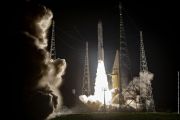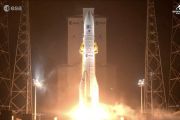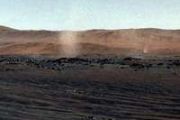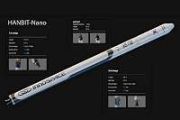
Copernical Team
Ariane 6 central core reaches Europe’s Spaceport
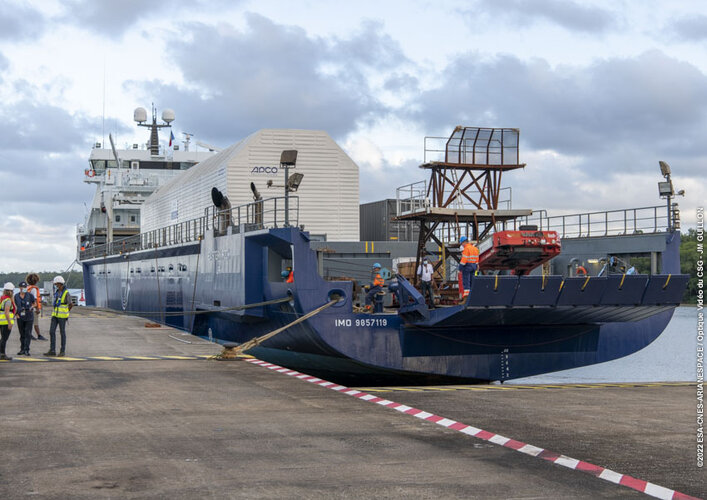
The central core of ESA’s new generation Ariane 6 launch vehicle has arrived in French Guiana from Europe. This enables combined tests at Europe’s Spaceport where Ariane 6 parts will come together on the launch pad for the first time.
First archaeological experiment in space

A world-first—or solar-system-first—archaeological project has this week begun on the International Space Station.
Led by archaeologists Associate Professor Alice Gorman from Flinders University and Associate Professor Justin Walsh of Chapman University in California, the International Space Station Archaeological Project (ISSAP) is the first archaeological study of a space habitat.
"We're the first to try to understand how humans relate to the items they live with in space," says Associate Professor Walsh.
"By bringing archaeological perspectives to an active space domain, we're the first to show how people adapt their behaviour to a completely new environment."
The team's first project, Sampling Quadrangle Assemblages Research Experiment, or SQuARE, has now launched, with an experiment that creatively imagines for space the most basic technique for sampling an archaeological site: the test pit.
While earth-bound archaeologists dig one-meter squares to understand a site and strategize further study, the ISSAP team will use adhesive tape to define one-meter areas of the International Space Station and then use daily photographs to study how the spaces are used.
"Instead of digging them to reveal new layers of soil representing different moments in the site's history, we will have them photographed each day to identify how they're being used and how they change over time," explains Associate Professor Gorman.
Astronaut selection: stage one complete

The next stage of ESA’s astronaut selection is underway, with around 1391 applicants invited to a full day of testing at a facility in Europe.
Hubble views a tranquil galaxy with an explosive past
 The lazily winding spiral arms of the spectacular galaxy NGC 976 fill the frame of this image from the NASA/ESA Hubble Space Telescope. This spiral galaxy lies around 150 million light-years from the Milky Way in the constellation Aries. Despite its tranquil appearance, NGC 976 has played host to one of the most violent astronomical phenomena known - a supernova explosion.
These cataclysmi
The lazily winding spiral arms of the spectacular galaxy NGC 976 fill the frame of this image from the NASA/ESA Hubble Space Telescope. This spiral galaxy lies around 150 million light-years from the Milky Way in the constellation Aries. Despite its tranquil appearance, NGC 976 has played host to one of the most violent astronomical phenomena known - a supernova explosion.
These cataclysmi Pebbles before mountains
 NASA's Mars 2020 mission team has been working methodically and thoroughly, making good progress on understanding the best path forward to remove the uninvited pebbles from Perseverance's bit carousel. Over the previous weekend, and earlier this week, operational sequences were developed and tested to remove these rocky interlopers.
With terrestrial experimentation complete, we have begun
NASA's Mars 2020 mission team has been working methodically and thoroughly, making good progress on understanding the best path forward to remove the uninvited pebbles from Perseverance's bit carousel. Over the previous weekend, and earlier this week, operational sequences were developed and tested to remove these rocky interlopers.
With terrestrial experimentation complete, we have begun Photon pairs are more sensitive to rotations than single photons
 In the field of quantum metrology, scientists are developing novel measurement schemes that benefit from quantum features and are more precise and sensitive than classical conventional methods. The team of researchers from Tampere University, Finland, and the National Research Council of Canada has now shown how a simple and powerful technique called two-photon N00N states can be used to create
In the field of quantum metrology, scientists are developing novel measurement schemes that benefit from quantum features and are more precise and sensitive than classical conventional methods. The team of researchers from Tampere University, Finland, and the National Research Council of Canada has now shown how a simple and powerful technique called two-photon N00N states can be used to create quub To Demonstrate Cybersecurity with Smallsat
 Scheduled to launch on a SpaceX Falcon 9 rocket on January 13, 2022, quub's pocketqube smallsat will serve as a proof of concept for the prevention of data hacks.
Data breaches cost millions of dollars every year. IBM's annual Data Breach Report indicates that the average worldwide cost per breach in 2020 was $3.86 million. In the U.S., the average cost per breach was $8.64 million.
Scheduled to launch on a SpaceX Falcon 9 rocket on January 13, 2022, quub's pocketqube smallsat will serve as a proof of concept for the prevention of data hacks.
Data breaches cost millions of dollars every year. IBM's annual Data Breach Report indicates that the average worldwide cost per breach in 2020 was $3.86 million. In the U.S., the average cost per breach was $8.64 million. The International Space Station connected via the SpaceDataHighway
 The Airbus' SpaceDataHighway - developed with the support of ESA - provides broadband connectivity services between the International Space Station (ISS) and the Earth. With the Columbus Ka-band (ColKa) terminal now installed and fully tested on-board the ISS, a SpaceDataHighway satellite will start to relay data via a bi-directional link in real time between the ISS Columbus Laboratory and the
The Airbus' SpaceDataHighway - developed with the support of ESA - provides broadband connectivity services between the International Space Station (ISS) and the Earth. With the Columbus Ka-band (ColKa) terminal now installed and fully tested on-board the ISS, a SpaceDataHighway satellite will start to relay data via a bi-directional link in real time between the ISS Columbus Laboratory and the China conducts its first rocket launch of 2022
 China launched a Long March 2D carrier rocket on Monday morning, kicking off the country's space program for 2022.
The rocket blasted off at 10:35 am at the Taiyuan Satellite Launch Center in northern China's Shanxi province and soon placed the Shiyan 13 experimental satellite in its preset orbit, China Aerospace Science and Technology Corp said in a statement.
This was China's first
China launched a Long March 2D carrier rocket on Monday morning, kicking off the country's space program for 2022.
The rocket blasted off at 10:35 am at the Taiyuan Satellite Launch Center in northern China's Shanxi province and soon placed the Shiyan 13 experimental satellite in its preset orbit, China Aerospace Science and Technology Corp said in a statement.
This was China's first Chinese scientists build 'Artificial Moon' to conduct experiments in low gravity
 According to the South China Morning Post, the facility located in Jiangsu Province, will play an important part in the exploration of the Moon as China plans to land its astronauts on Earth's satellite by 2030 and set up a base there.
Chinese scientists have built an artificial moon that will make it possible to conduct experiments in low gravity. According to the researchers, their creat
According to the South China Morning Post, the facility located in Jiangsu Province, will play an important part in the exploration of the Moon as China plans to land its astronauts on Earth's satellite by 2030 and set up a base there.
Chinese scientists have built an artificial moon that will make it possible to conduct experiments in low gravity. According to the researchers, their creat 
